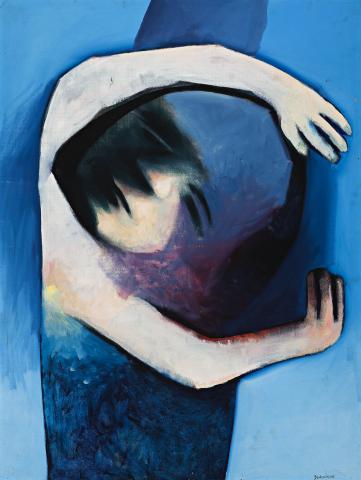HERSELF FORGIVEN: FIGURE FROM A DRAMA, 1963 (FROM ‘FIGURES FROM A DRAMA: SIX CHARACTERS IN SEARCH OF AN AUTHOR’)
CHARLES BLACKMAN
oil on composition board
121.5 x 91.5 cm
signed lower right: BLACKMAN
The Collection of Barbara Blackman, Canberra
Three Australian Painters: Charles Blackman, Arthur Boyd, Allen David, Towner Art Gallery, Eastbourne, United Kingdom, January 1964
Moore, F. St. J., Charles Blackman: Schoolgirls and Angels, National Gallery of Victoria, Melbourne, 1993, p. 84
Figures from a Drama (Dramatis Personae), 1963, oil on hardboard, 120.6 x 90.5 each, illus. in Moore, F. St. J., Charles Blackman: Schoolgirls and Angels, National Gallery of Victoria, Melbourne, 1993, p. 84
Blackman’s closest association with an artist occurred in London (1961 – 66) where he and Arthur Boyd regularly went to galleries together and pooled their growing technical expertise. They made a weekend visit to Amsterdam to see the Rembrandts, and Charles pursued Goya’s pictures from London to Paris and the Prado. For both painters, London was a doorway to real ‘hand-made’ works of art, to contemporary literature and theatre and to the richness of the European tradition.
Charles was also reading to Barbara plays and drama books from the library of Max Nicholson which were left in their care. The combination of figures and confinement in Herself Forgiven recalls the plays of Samuel Beckett (on whom Nicholson was an authority) which they read and saw in London.
Herself Forgiven is the new title Barbara has given to this panel which was originally exhibited in Eastbourne in a six panel suite with the tantalizing subtitle of Six Characters in search of an Author (after the Pirandello play). In it her outstretched arms offer a kind of open embrace for her shadowed face and stream of burnished, loosely brushed hair. She is the personal within the universal: the eternal feminine emerging from darkness into light, as on a stage. The tenderness of Barbara’s face remembered is exacerbated by the tension of her raised arms which stand out from the deeper blue tones of the artist’s own shadowy figure behind.
Along with his larger family paintings, such as The family, 1962 (National Gallery of Australia, Canberra) and Venetian lovers, 1962 (Art Gallery of South Australia, Adelaide) the present painting Herself Forgiven was precipitated by the artist’s fear of their family breaking up. In the words of Australian poet and playwright Ray Mathew who wrote the Charles Blackman 1965 monograph: ‘The woman trembles or is still, she dreams or waits. She is vulnerable, passive, ready for acceptance or denial, hurt or strength. The hand she holds out, the touch she feels… Only one thing is certain: it is a momentary thing, and she knows it. With what tenderness and what authority, the artist lets us know it too.’1
Blackman painted this and his other family paintings in his Archway Road semi-basement studio when the family were living in Highgate not far from the Boyds in Hampstead. At a time when his reputation was rising rapidly with support from writers, curators and critics, it was chosen for the Three Australian Painters exhibition (with Arthur Boyd and Allan David) before hanging more recently on Barbara’s bedroom walls in Sydney and Canberra.
1. Mathew, R., Charles Blackman, Georgian House, Melbourne, 1965, p. 9
FELICITY ST JOHN MOORE
